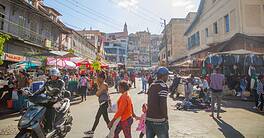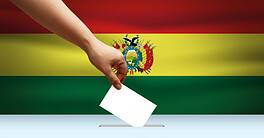Conflict aside, the Middle East is anticipating a period of economic growth. Here are some of the trends shaping the future of the MENA economies.
Last year was a sadly eventful one for the Arab world. The wars in Gaza and Lebanon sent shockwaves across the region: disrupting key trade routes, derailing normalization talks between Israel and Saudi Arabia, accelerating Egypt’s economic bailout, and precipitating the fall of the Assad regime in Syria. Further west, conflicts in Sudan and the Sahel put pressure on North African economies like Egypt, Libya, and Morocco.
The long-term effects of these conflicts are still a question mark, and the arrival of Donald Trump in the White House adds further uncertainty. The new US administration’s economic policies, particularly regarding trade and oil, could have deep implications for Middle Eastern economies.
And yet, growth persists.
According to the IMF, the region is expected to enjoy 3.8% growth in GDP in 2025, up from 1.9% in 2024, while North Africa is projected to expand by 4% compared with 2.9% last year. The United Arab Emirates (UAE), Saudi Arabia, and Egypt—the region’s largest economies—are also expected to be its strongest performers, with projected GDP growth rates of 5.1%, 4.6%, and 4.1%, respectively, in 2025.
The Middle East, and especially the Gulf Cooperation Council (GCC), remain heavily reliant on hydrocarbon exports; a gradual phase-out of OPEC+ production cuts is expected to support immediate revenue growth. In parallel, the non-oil sector is getting stronger year over year, a sign that diversification stra-tegies, put in place over the last decade, are beginning to bear fruit. With over $2 trillion in planned infrastructure projects, the Middle East appears to be at the starting point of a long-promised economic transformation.
Here are some of the trends to keep in mind.
Arab Banks Thrive
The banking sector is likely to remain a pillar of the MENA economies, as governments remain strongly committed to driving development through local financial institutions, be they in mature markets or war-torn nations (see interview on page 79 with Wissam Fattouh from the Union of Arab Banks).
In December, Fitch Ratings confirmed Middle East banks’ “neutral” outlook. The agency predicted that credit growth will pick up in most countries and that lenders will maintain profitability, liquidity, and asset quality.
While traditional banks remain the region’s main financial players, fintech continues to thrive in the MENA markets, driven by regulatory reforms and a strong push for digital transformation across sectors. The six-nation GCC clearly has the lead in innovation as governments and local banks partner with small companies on projects around digital payments but also blockchain, crypto, and artificial intelligence.
Last year, 119 Arab fintechs attracted $700 million in investment, 30% of total startup funding for the region. The most dynamic market was the UAE, closely followed by Saudi Arabia. The biggest deals include $157.5 million for Egypt’s MNT-Halan, $67.5 million for Dubai open banking firm Lean Technologies, and $50 million for Bahrain payment solution provider AFS.
Fintech enables leading economies to offer cutting-edge financial services to affluent customers and stay competitive in the global AI race, but it also promises to help bridge divides across the MENA region by addressing the needs of the underbanked in the region’s poorest countries. This will be a hot topic in 2025 in troubled countries like Syria, Lebanon, Yemen, Iraq, Tunisia, and Egypt, where financial inclusion tools are creating new ways to handle money.
Surge In IPO And M&A Activity
Opportunities are also opening up in the region’s capital markets. Last year saw a strong rebound in MENA’s investment banking sector, with 701 mergers and acquisitions, up from 679 in 2023, totaling more than $92 billion in value, up 7%. The MENA countries were collectively one of the busiest areas globally for IPOs, with 54 deals raising $12.6 billion, for a 12.5% year-on-year increase in the number of deals and a 17.6% jump in proceeds, according to Ernst & Young’s February IPO EYE MENA report.
The IPO surge is expected to carry on this year with over 50 deals already in the pipeline, including Abu Dhabi’s Etihad Airways, Saudi Arabia’s Panda Retail chain and Dubai’s Amanat Holding, which invests in the health care and education sectors. A growing number of family offices are also expected to list in the years to come.
Saudi Arabia and the UAE dominated the regional IPO markets, both for number of deals and value of shares traded in 2024, but there are signs that the geographical range will be higher this year.
In October, the sultanate of Oman stepped out with its largest IPO ever, selling 25% of government-backed OQ Exploration and Production for $2 billion. In January, Asyad Group, a public logistics company, announced it would sell 20% of its shipping unit, Asyad Shipping. In total, Oman plans to list at least 35 state firms in an effort to reduce debt and increase foreign investment.
Egypt is another huge market for IPOs, also driven by state-owned companies looking to bring in private investors. Last year, the Egyptian Stock Exchange (EGX) saw the successful listing of United Bank, which raised $92 million by selling 30% of its ownership. Act Financial, a private investment company, raised over $30 million. Many more companies are anticipated to go public in 2025, including Misr Pharmaceuticals Industries; the Gabal el-Zeit wind station; Wataniya, a telecom firm; water bottle manufacturer Safi; Silo Food; Tabarak Developments Holdings, a real estate group; Alexandria Bank; and Banque du Caire.
Algeria is another unexpected yet surprisingly dynamic market. Last year, the Algiers Stock Exchange saw the listing of Crédit Populaire d’Algérie, a local bank that raised $837 million, as well as its first digital start-up IPO called Moustashir. At least three more public offerings are expected in 2025 as Africa’s biggest country tries to modernize and open up its financial sector.
From Oil To Renewables
While the MENA region is home to some of the world’s biggest hydrocarbon producers, governments are recognizing the need to adapt to climate change. Some see themselves as leaders in tomorrow’s energy markets.
MENA renewable energy capacity is set to triple from 53 gigawatts (GW) in 2023 to 150 GW by 2030, with solar panels driving 85% of this growth according to the 2024 renewables report from the International Energy Agency. Major projects are underway in the region’s largest economies, including Saudi Arabia’s Al Shuaibah solar plant, the UAE’s Mohamed Bin Rashid Al Maktoum solar park, Egypt’s Benban energy station, and the Noor projects in Morocco.
Even crisis-hit countries are joining the trend. In Lebanon and Syria, solar panels have become a common sight on rooftops, providing households with a reliable alternative during frequent power cuts.
The corporate sector is also shifting as more MENA-area companies commit to solar-powered production as one of their sustainability strategies.
Other clean energy sources are gaining traction across the region as well. Last year, Saudi Arabia and Egypt signed some of the world’s first green ammonia contracts, while blue and green hydrogen projects are commencing in several GCC states.
To boost their green energy initiatives, MENA countries are also securing access to rare metals. Last year, Saudi Arabia revised its estimate of its untapped mineral resources from $1.3 trillion to $2.5 trillion and began signing exploration MoUs with international firms. Countries lacking domestic resources are seeking them abroad. The UAE, for example, has inked several mining agreements in Africa, including a $1.9 billion deal with the Democratic Republic of Congo.
For now, however, oil and gas will remain the regional mainstay. Despite growing investments in renewables, fossil fuels still account for over 80% of global energy consumption, according to S&P Global. With demand on the rise, countries like Algeria, Libya, Egypt, Iraq, Oman, Saudi Arabia, the UAE, Kuwait, and Qatar have no plan to stop pumping hydrocarbons.
On the contrary, many will be substantially expanding production capacities in the next few years, ensuring robust revenues and business prospects.
| Top 5 MENA Startup Deals in 2024 | |||
|---|---|---|---|
| Company | Country | Sector | Amount Raised |
| MNT-Halan | Egypt | Fintech | $157.5 million |
| Eyewa | UAE | Online eye ware retail | $100 million |
| SHIFT | Saudi Arabia | Logistics | $83 million |
| Lean Technologies | UAE | Fintech | $67.5 million |
| AFS | Bahrain | Fintech | $50 million |
| Top 5 MENA IPO Deals In 2024 | |||
|---|---|---|---|
| Company | Sector | IPO Value | Market |
| Talabat Holding | Food delivery | $2 billion | Dubai Financial Market (DFM) |
| OQ Exploration and Production (OQEP) | Oil and gas | $2 billion | Muscat stock exchange (MSX) |
| Lulu Holding | Retail | $1.7 billion | Abu Dhabi Securities Exchange (ADX) |
| NMDC Energy | Energy | $877 million | Abu Dhabi Securities Exchange (ADX) |
| Crédit Populaire d’Algérie | Bank | $837 million | Algiers stock exchange |




